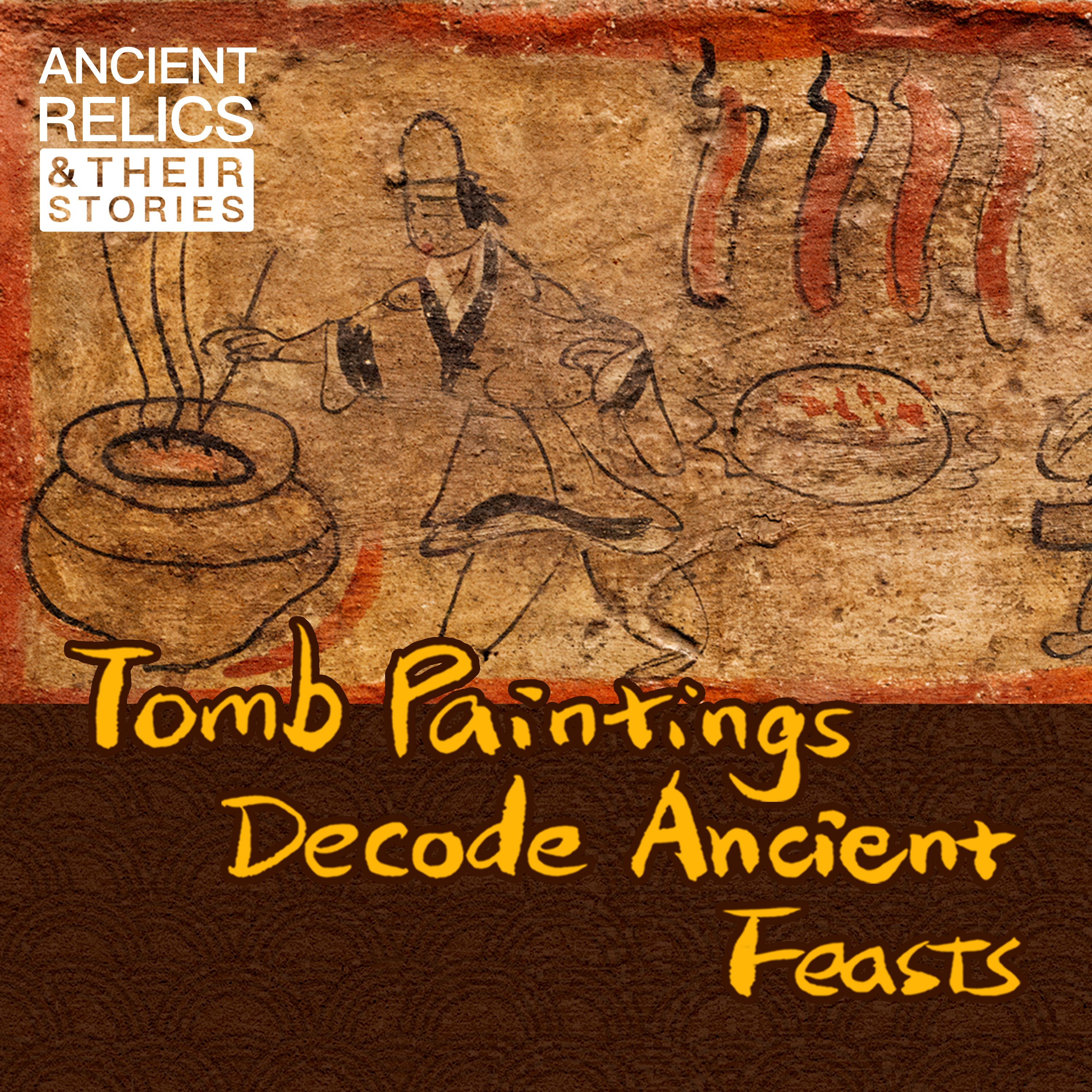
Deep Dive
- The Wei and Jin dynasties (220-420 CE) were marked by widespread political instability in China.
- The Hexi Corridor in northwestern China remained relatively prosperous.
- Wealthy families and scholars migrated to the Hexi Corridor to escape the conflict.
- The corridor's strategic location and military presence ensured relative stability.
- Diverse ethnic groups coexisted in the Hexi Corridor, leading to a prosperous society.
Shownotes Transcript
You're listening to Ancient Relics and Their Stories, a special series of A Thousand Whys. The Wei and Jing periods between 220 and 420 CE were marked by political turbulence across much of China. But the upper classes in the Hexi Corridor of northwestern China were still enjoying an affluent lifestyle. How do we know this? Welcome to the third episode of Ancient Relics and Their Stories. I'm Ling Xiaowen.
From at least 162 paintings found on the brick walls of thousands of underground tombs unearthed in the Hexi Corridor, northwest China, were found evidence of this lifestyle, even at a time of chaos. It was the lifestyle in a secluded area of relative abundance, like a rare haven, marked by lavish banquets with exquisite meats and fine wine.
The time for Wei and Jing states was mainly a disastrous warring era but it was also a time when many rich families and renowned scholars were able to escape from politics and retreat to seclusion filling their days drinking wine, reciting poems. Those paintings captured such lavishness with details about the delicacies they enjoyed the way food and drink were prepared and served the kitchen and tableware
the recreation at banquets, and duties performed by different servants for the rich and powerful. The paintings offer a window to the way of life, the nature of society, and cultural beliefs of that place in that era. The Hexi Corridor lies to the west of the Yellow River. It was an important route reaching from the central plains of China, nowadays Henan Province, to the west and eventually to Central Asia during ancient times.
It served as an important traffic hub along the ancient Silk Road and played a crucial role in historical, economic and cultural exchanges. During the Wei and Jing periods, the central government was located on the central plains, which was mired in political turbulence and internal conflict.
Although not free from small conflicts from time to time, the Hexi Corridor, on the contrary, was a relative paradise. Therefore, some rich families from the Central Plains resettled in the corridor to escape from endless wars. Moreover, as several key military fortresses were located along the corridor, the Central Government stationed soldiers at each border outpost.
There followed waves of migrants who didn't have arable land at home and went on to develop agriculture in the region, also ensuring a stable food supply for the soldiers. As a result, the Hexi Corridor became home to diverse ethnic groups such as the Han and the original residents like the Di, Qiang and Xianbei, where the relatively stable society and a steady economy came at prosperous time.
In ancient times, meat was as scarce as caviar, but they could still be seen on important occasions and festivals. Although cooking was still rather a simple matter, barbecues and kebabs were available on the menu. One tomb painting features a man cutting meat into slices while another placed raw meat on a grill.
Several curves above the hot grill indicate swirling smoke rising into the air, evoking the aroma from melted, dripping away from sizzling meat. Another picture depicts a man holding a skewer in his hand. Unlike the ones we use today, the skewer resembles a garden fork with three points, each with several chunks of meat.
Surrounded by the Gobi Desert, the Hershey Corridor was dotted with a string of oases, providing essential pasture and water resources for developing livestock farming. Migrants from the Central Plains brought advanced agricultural skills to the area. Considering the dry climate throughout the year, strong winds in spring and autumn, and exceptionally long winters, millet and wheat were widely cultivated in the region.
with millet being the primary crop. Hot millet porridge in cold winter brings warmth and comfort, but trust me, it wasn't as tasty as we'd think, since techniques for removing millet husks was not known yet. But it was perhaps the best way to cook this grey, as other methods, such as steaming, would make it even harder to chew, and it might even get stuck in the throat.
Don't worry though, there was more to the porridge, which was often served with pickled vegetables in that era. Try not to set your expectations too high. Due to the severe climate and limited farmland, edible wild plants of salty or sour flavours were the more common dishes.
We can even find clues to vinegar making on one tomb painting, which features three cylindrical pots placed on a table, each with a smaller bowl positioned beneath to catch the falling liquid. This is the image of traditional vinegar production, which can still be found in the region using the same ceramic container in the painting. Besides the local cuisine, people in the era were already enjoying food from elsewhere.
As we said, wheat was also planted in the Hexi Corridor. It was originally introduced from West Asia during the Shang Dynasty more than 3,000 years ago. Although using wheat to make bread has been a tradition in many Western countries, the cooking method of wheat in China became more localised. We steam them into buns instead.
Thanks to the invention of millstone, people in that period have begun to grind wheat into flour. One painting depicts rounded objects resembling steamed buns piled into a mound in the kitchen, with a maid kneading dough with sleeves rolled up high on her arms.
Another staple food made from wheat was pancakes or bing in Chinese, which was introduced from Central Asia during the Han Dynasty about 2,200 years ago. A tomb painting portrays a maid stretching a piece of dough into a big and round shape before dropping it onto a pan, making pancakes that were crispy on the outside and tender inside. Banquet time!
Similar to the prominent Crawley family portrayed in the British historical drama Downton Abbey, the gentry from Wei and Jing periods often organised and hosted social functions with dinner parties being the common and festive event. Everything had to follow the protocol and order. One tomb painting features four maids carrying food in a line, either on the way to the dining room or awaiting instructions for serving.
Another features a family enjoying a meal accompanied by music and dancing. What a delightful treat! And there was a code of etiquette on how food was served, guiding the behaviours of ritual and social practices. In one painting, a servant distributes food for two ladies with different portions according to their social ranks and ages. Higher status and elderlies were provided with more food.
Seating also indicates social ranking, with the most honourable facing east. But they sat not on chairs as today, but on the floor, because the tables were short. This way of serving food gradually changed during the Tang Dynasty after the year 618, influenced by the emergence of higher furniture, which is more convenient for placing dishes in the centre for people to share.
Protocols also apply to servants, such as the head chef who wore the tallest white hat. Lower racks, shorter the hats. As the Chinese saying goes, good wine must go with delicacies. Wine was an essential part of the gentry's life, a symbol of wealth and social class.
Due to social instability and corruption, a mentality of pursuing pleasure to escape reality was common in that era. Moreover, several famed elite literati celebrated drinking as an act of self-liberation and a method for inducing artistic creativity, making wine a necessity of their leisure time. This resulted in rapid development of the wine industry in that era.
One tomb painting features a rectangular wine vessel on a short table with three people seated beside it, ready to refill cups at any time. A spoon with a long handle is placed above the wine vessel.
Spoon was commonly used for serving porridge and pouring wine into glasses. Chopsticks were more frequently used in the kitchen, such as for barbecuing and picking up hot food. It was later that they gradually became the primary eating utensils with the rise of steamed rice, noodles and dumplings. Eating utensils were often made of bronze and lacquered wood.
with the more exquisite ones made of jade. High-end or tailor-made wares were engraved with the maker's name, which were used to ensure its perfection and provide a means of accountability should things go wrong. This is perhaps the ancient spirit of craftsmanship. Apart from the posh lifestyle of the gentry, many tomb paintings portray the lives of the servants too, whose duties relied on a strict division of labour.
there were three individuals who chose to work for the wealthy to make a living. To prepare for the feast, male servants slaughtered animals, cut meat into pieces before grilling, while female servants were busy in the kitchen making dough, steaming buns and cooking porridge. When you see a big animal being slaughtered, such as a cow, a lamb or a pig, that sure meant it was an important occasion.
When dinner began, they followed protocols to ensure the smooth proceeding of the banquet. Delivering dishes, distributing food, refilling cups with wine, catering to individual needs, playing music and performing dances, all were executed in order. If you'd like to see these intricate tomb paintings in person, you can find some of them in the Gansu Provincial Museum.
Here I would like to extend my sincere thanks to the museum and its associate researcher Liu Zhihua for helping us understand what was portrayed, the scenes, the people and the society at that particular time and place.
In the next episode, we'll introduce a pair of bronze owls unearthed from the tomb of a queen, a politician, and a goddess of war who was the first female general ever recorded in history, who lived during the Shang Dynasty more than 3,000 years ago. Until then, bye for now.
